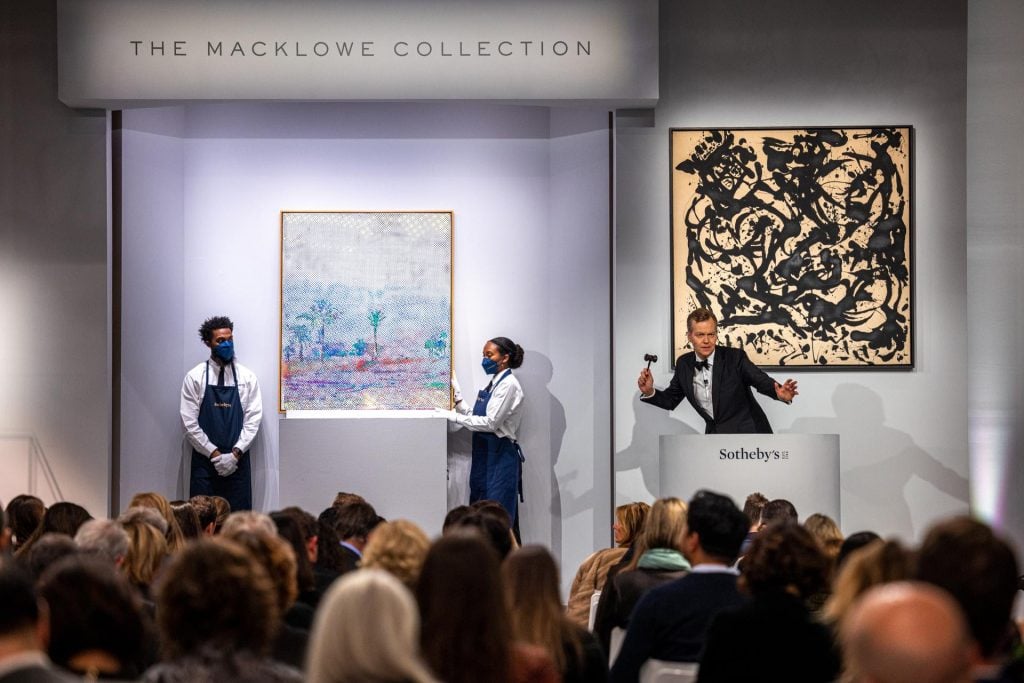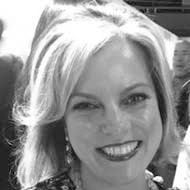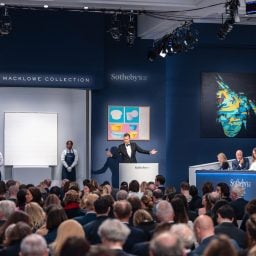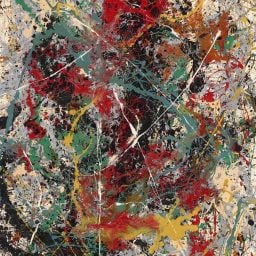The high-end art market breathed a sigh of relief as trophies from the Macklowe Collection by artists including Mark Rothko, Alberto Giacometti, and Jackson Pollock generated an eye-watering $676.1 million at auction on Monday.
The highly anticipated event was ordered by the court as part of the bitter divorce between real-estate developer Harry Macklowe and his museum trustee ex-wife Linda. The 35 lots offered on Monday were expected to bring $444 million to $619 million. Every single one sold and Sotheby’s heralded the results as the most valuable sale in its history. More Macklowe material will be offered in May.
“I am very, very pleased and happy,” Harry Macklowe said after the auction. “I feel very privileged.”
Both warring exes attended the event, though Linda—who has been credited as the lead architect of the collection, and who fought unsuccessfully to keep the works from hitting the auction block—watched from a skybox and did not speak to the press. Harry, sporting a long, richly patterned scarf around his neck, said he is as proud of the collection he built with his ex-wife over six decades as he is of any of his buildings.

Sotheby’s billionaire owner Patrick Drahi and Harry Macklowe in front of Jackson Pollock’s Number 17, 1951. Photo: Katya Kazakina
The sale was the biggest test of the high-end art market since the world went into lockdown 19 months ago. While the mood in the room was subdued and competition for many of the lots was relatively sparse, international bidding from 25 countries boosted the results. Four artworks fetched more than $50 million—twice as many as sold in all of 2020. The average lot price was, astoundingly, $19.3 million.
Like at Christie’s 21st century auction last week, the lion’s share of the offerings—almost 80 percent of the sale’s estimated value—was backed by irrevocable bids, meaning those works were essentially presold. While a necessary part of financial wizardry, such arrangements often dampen live bidding, as was the case with several key lots at Sotheby’s.
“Financing is part of the competitive landscape,” said Evan Beard, head of private business services at Bank of America. “They are managing risk like an investment bank does.” Sotheby’s won the consignment in part by guaranteeing the former couple a minimum price no matter what happened at the auction.
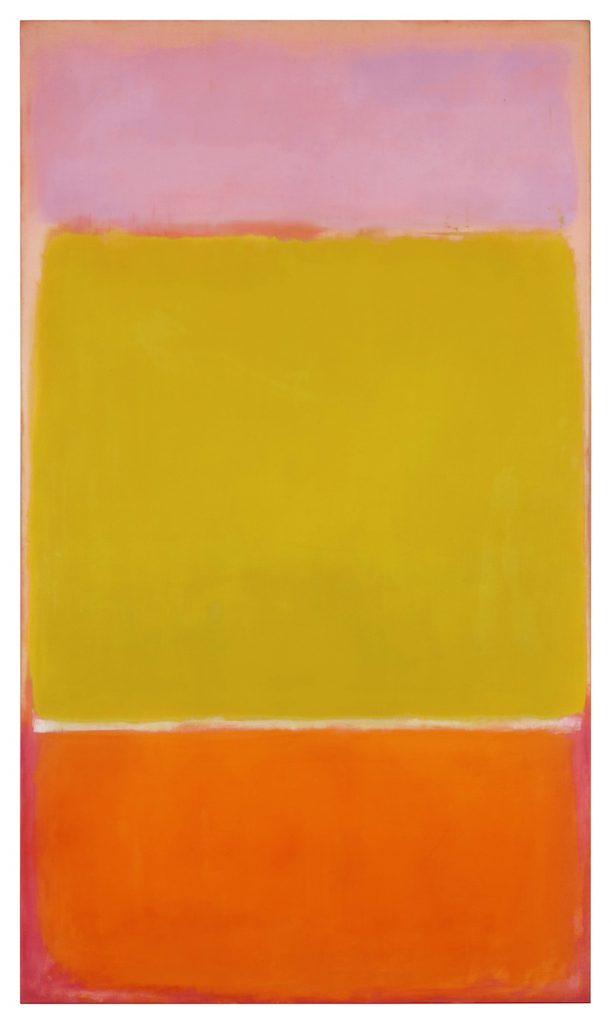
Mark Rothko, No. 7 (1951). Photo courtesy of Sotheby’s.
The top lot of the night was Rothko’s No. 7 (1951), snapped up by a client of the chairman of Sotheby’s Asia for $82.5 million. The eight-foot-tall canvas featuring horizontal bands of pink, yellow, and orange, which had never before appeared at auction, was expected to bring in $70 million to $90 million. It fell just short of setting a new auction record for the Abstract Expressionist, whose top price is $86.9 million. (Final prices include buyer’s premium unless otherwise noted; pre-sale estimates do not.)
Giacometti’s Le Nez (1947), a haunting post-World War II sculpture of a bronze head with an extremely long, pointy nose, hammered for $68 million, below the low estimate of $70 million. The final price with fees came to $78.4 million, smack in the middle of expectations. After the sale, Justin Sun, the BitTorrent CEO and Chinese cryptocurrency investor who was the underbidder for Beeple’s $69.3 million NFT, tweeted that he was the buyer of the sculpture. Sotheby’s had previously confirmed the buyer came from Asia.
Out in force, Asian bidders also pursued works by Willem de Kooning, Agnes Martin, and Gerhard Richter.

Giacometti’s Le Nez and Warhol’s Nine Marilyns. Courtesy of Sotheby’s.
Not every high price was orchestrated in advance. Pollock’s Number 17, 1951, a painting of inky black swirls that resemble a very complex Rorschach test, was a surprise success. It sold for $61.6 million, smashing its $35 million high estimate and surpassing the artist’s previous record of $58.3 million, set for a more characteristic drip painting in 2013.
Martin’s Untitled #44 was another less expected hit. Estimated at $6 million to $8 million, the 1974 Minimalist canvas was acquired by the Macklowes the year it was made. It ended up selling for $17.7 million, a record for the artist, after being chased by five bidders.
Cy Twombly’s 18-foot-wide untitled painting of dripping red flowers on a light green background sold for $58.8 million, on the upper end of its $40 million-to-$60 million estimate. The Macklowes also acquired it the year it was made, in 2007, from Gagosian gallery in New York. Each work in the show was priced at $5 million, according to Matthew Armstrong, the former curator of Donald Marron’s collection, which bought another piece from the series. (“Ours was the best of the bunch,” he added.)
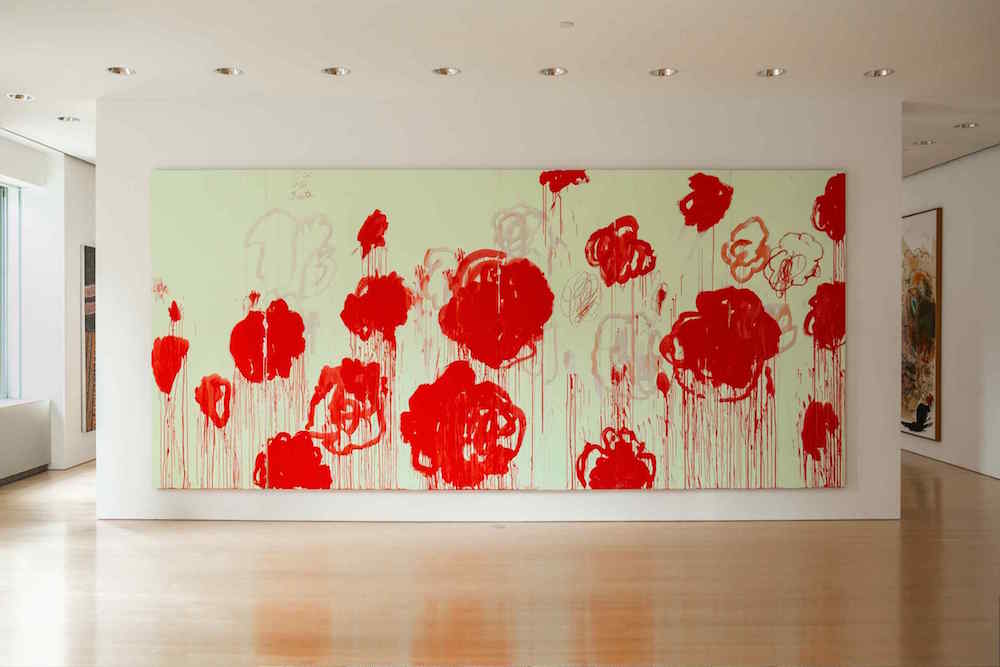
Cy Twombly, Untitled (2007). Image courtesy Sotheby’s.
Two paintings by Andy Warhol also landed among the top 10 lots. Nine Marilyns (1962) sold to its guarantor for $47.4 million, against the estimated range of $40 million to $60 million. It was initially bought by art advisor Jude Hess, but Sotheby’s reopened the lot later in the sale; it ultimately sold for $1 million less than she had bid. It was unclear whether the unusual move was due to a case of buyer’s remorse; Sotheby’s couldn’t immediately explain what happened.
While some experts had worried in the run-up to the sale that the top-quality collection might fail to attract the same level of excitement as hot, in-demand emerging artists have in recent months, the heavyweight prices proved that the top of the market has emerged from lockdown strong, even if the air up there is comparatively thin.
Sotheby’s worked hard to ensure it would deliver. In addition to lining up a phalanx of guarantees, the auction house sent the works on tour to Taipei, Hong Kong, Tokyo, Shanghai, London, Los Angeles, and Paris before they arrived in New York. (Once they got there, the company also invited music stars and social-media influencers for a private tour.) More than 27,000 people attended the previews around the world.
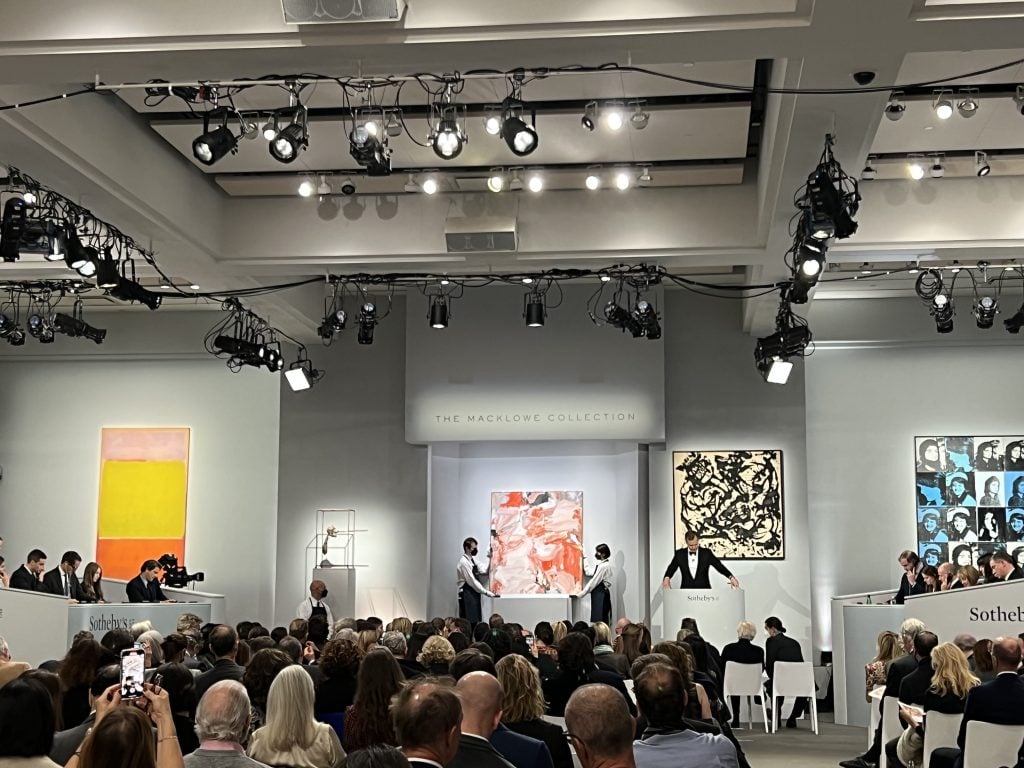
The scene at Sotheby’s Macklowe Collection sale. Photo: Katya Kazakina.
Sotheby’s has six more auctions to go this week, offering over $400 million worth of art. Rival Christie’s generated $1.1 billion from its series of sales last week.
But it’s the Macklowe auction for which this season will be remembered. The sheer number of masterpieces offered at once was unprecedented, according to Oliver Barker, the evening’s auctioneer.
“Tonight was the kind of sale auctioneers dream about,” he said after the event. “It’s probably a once-in-a-lifetime experience.”
